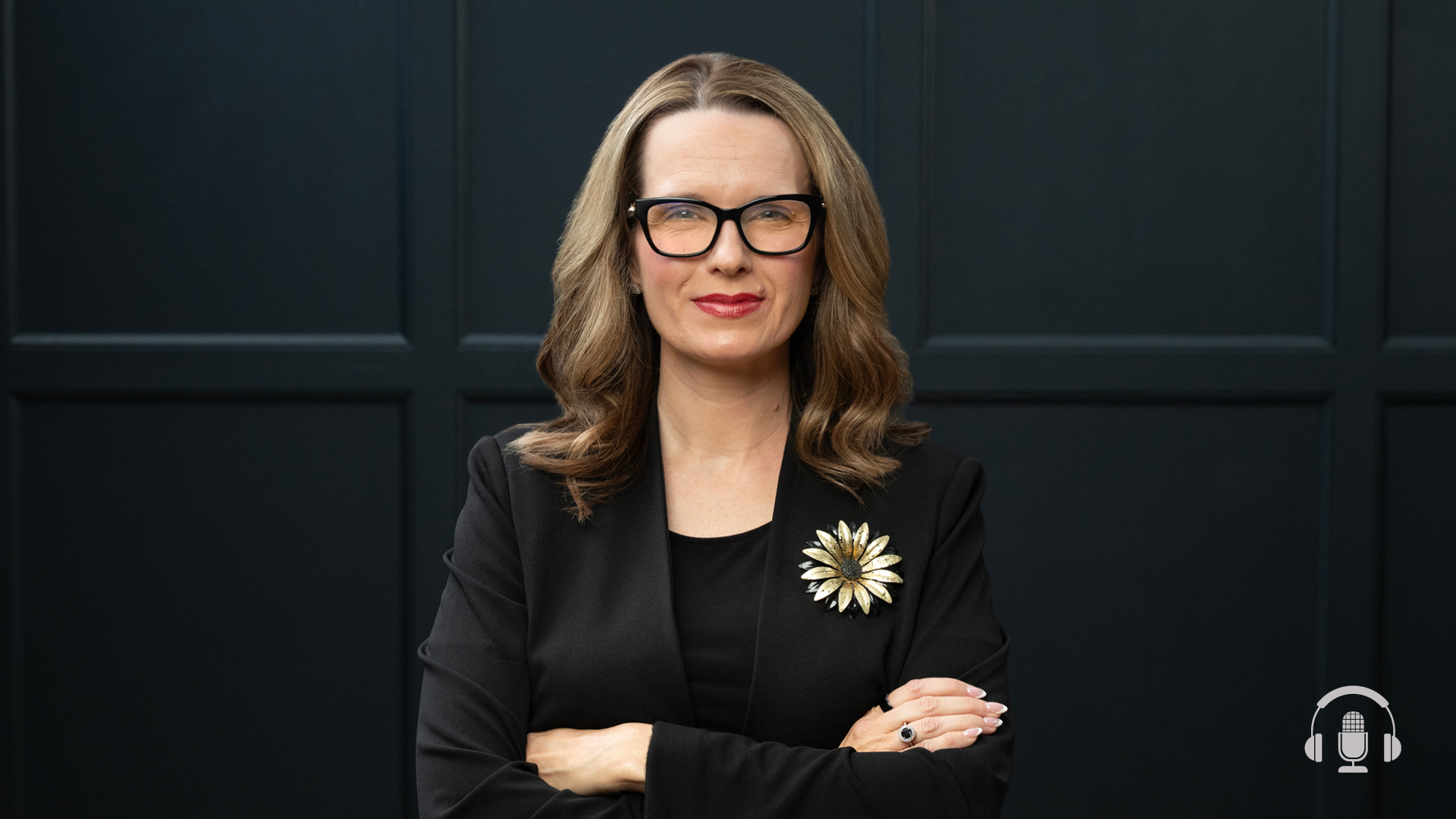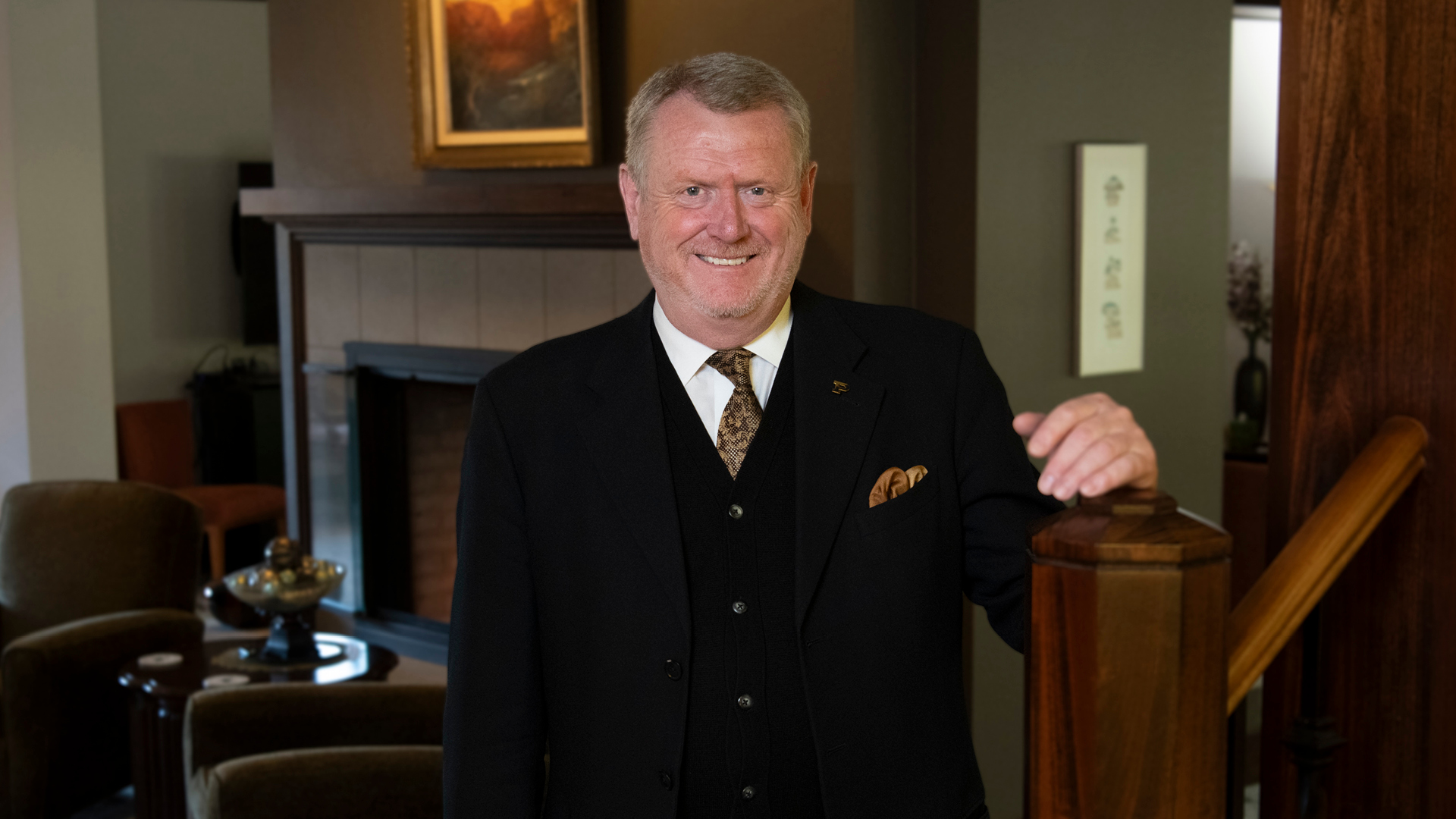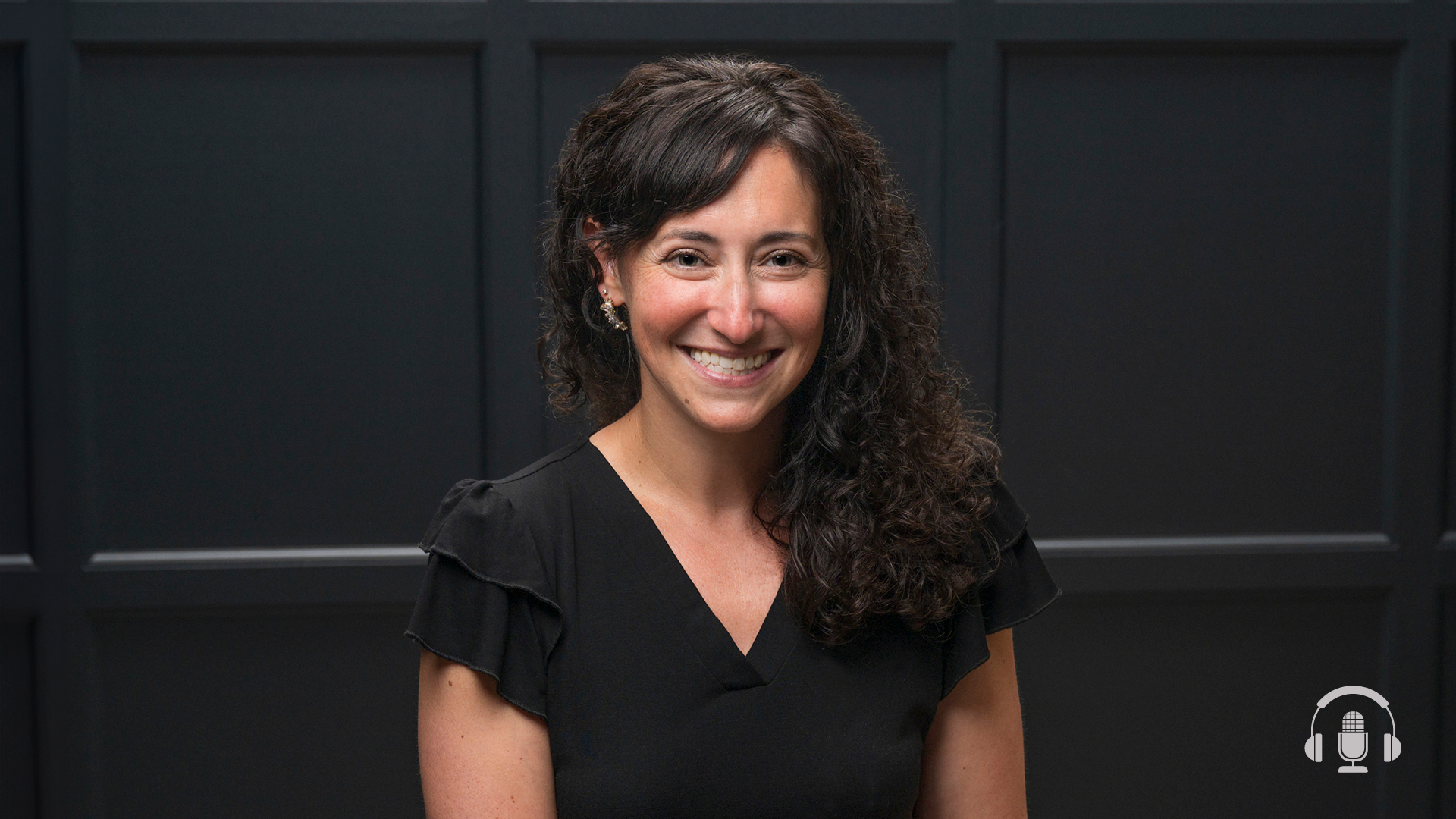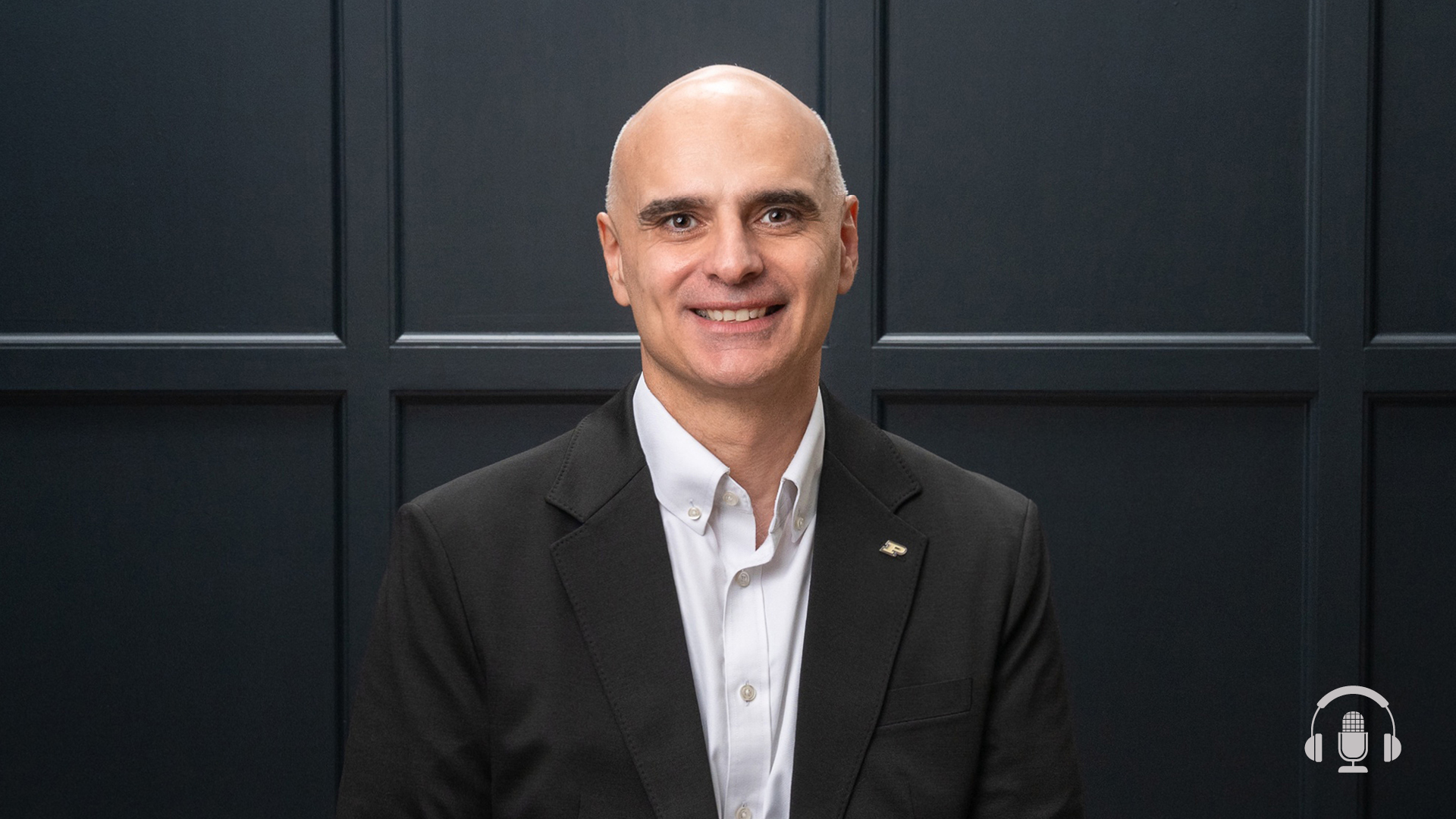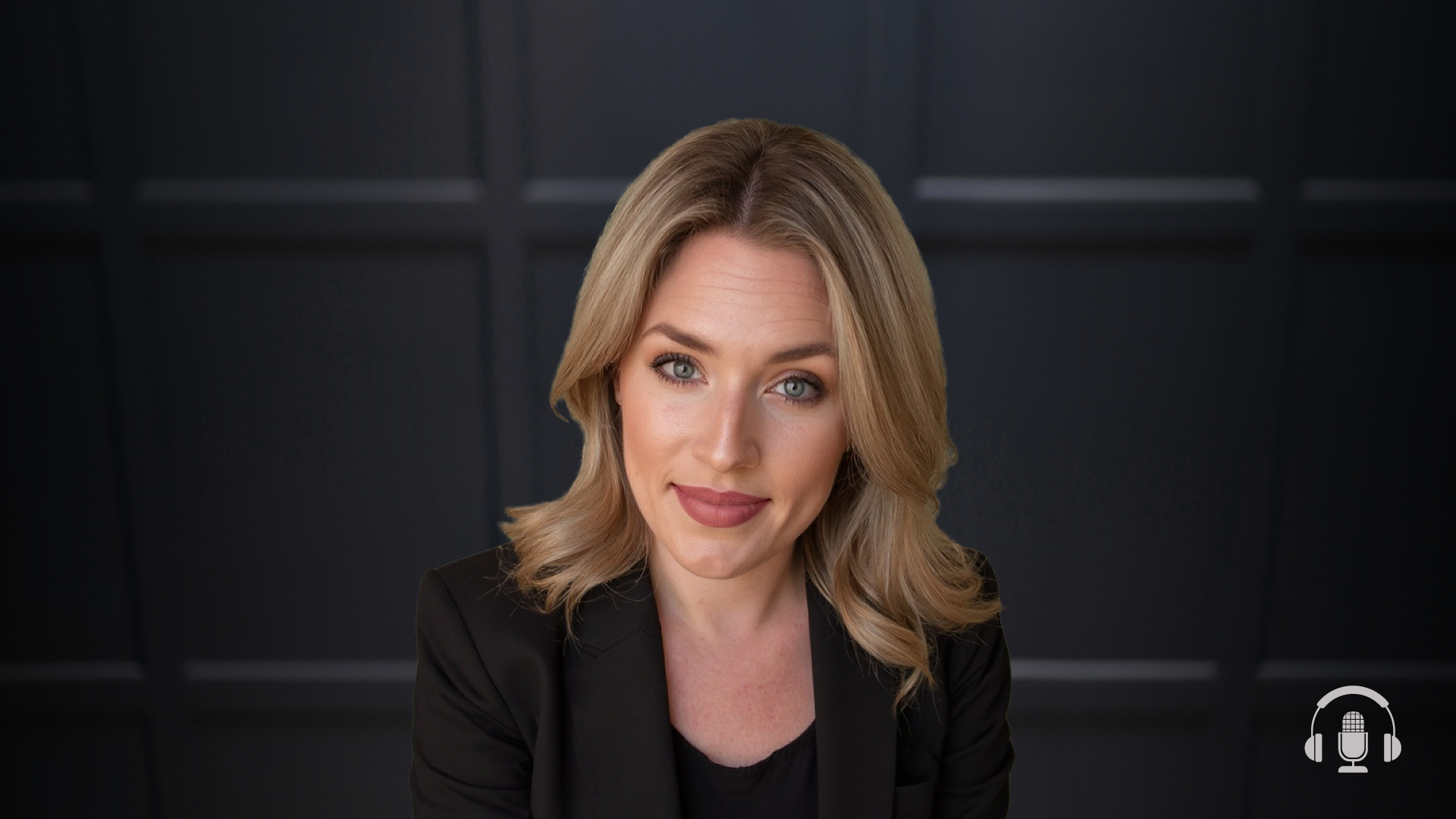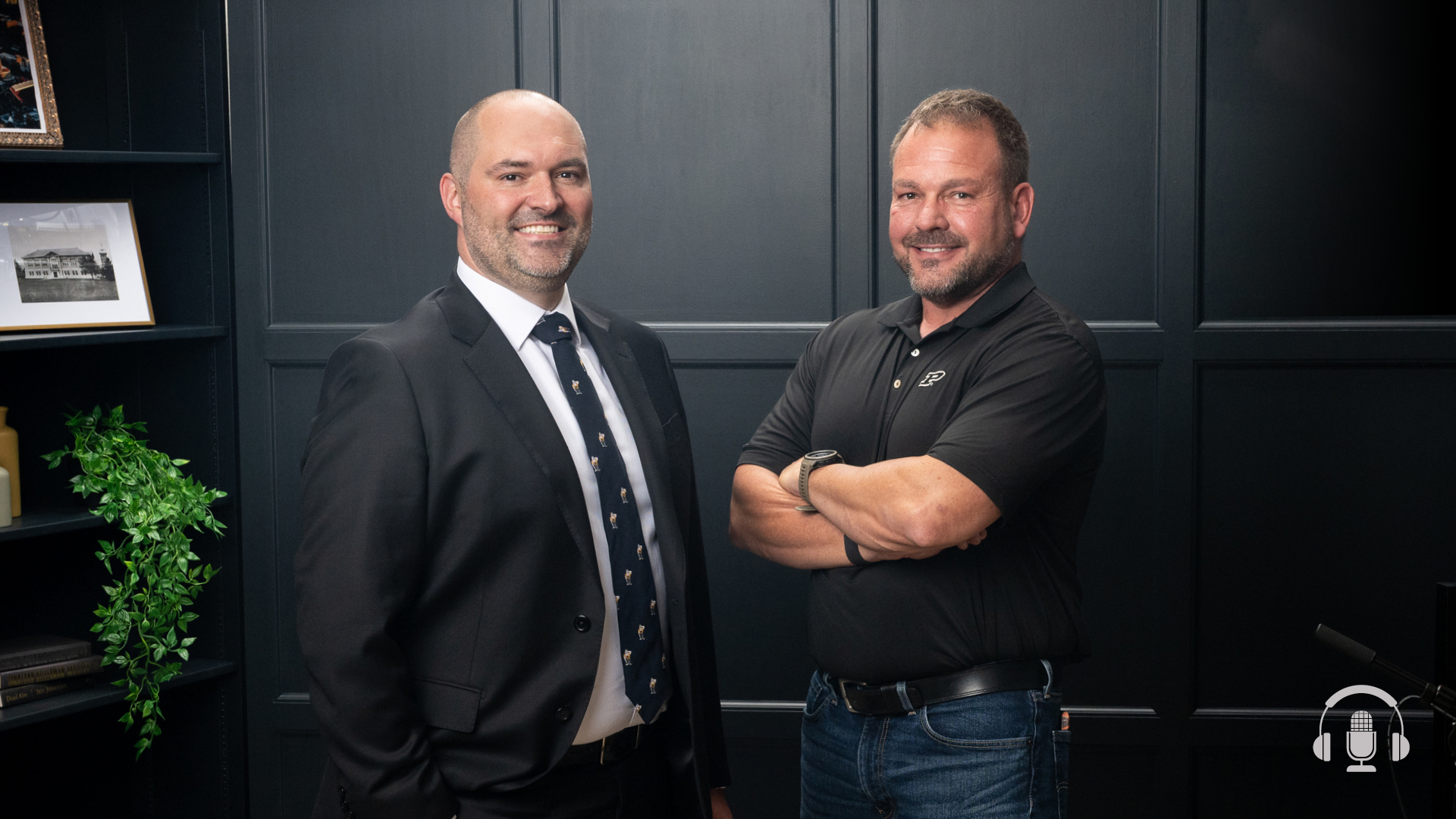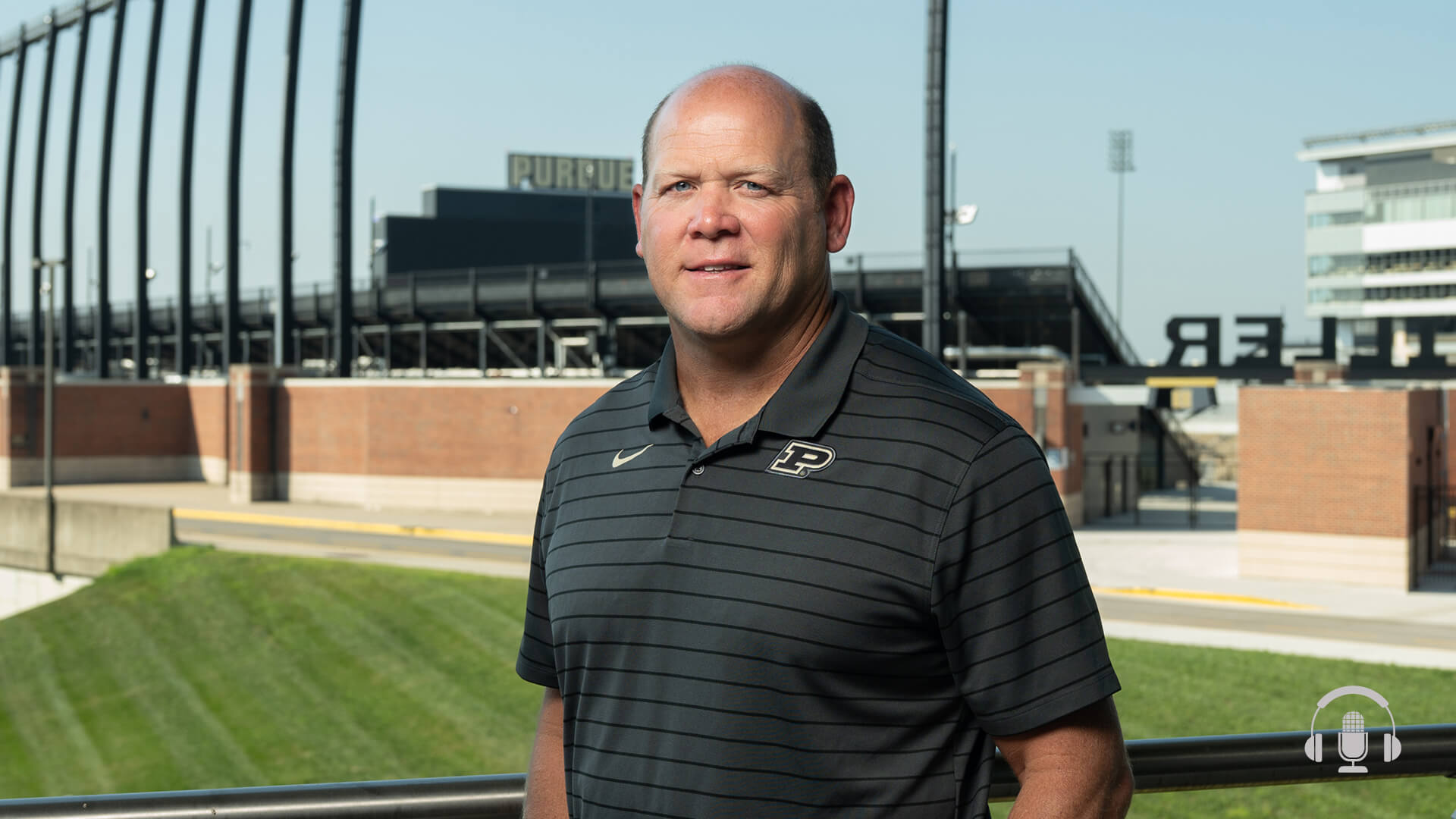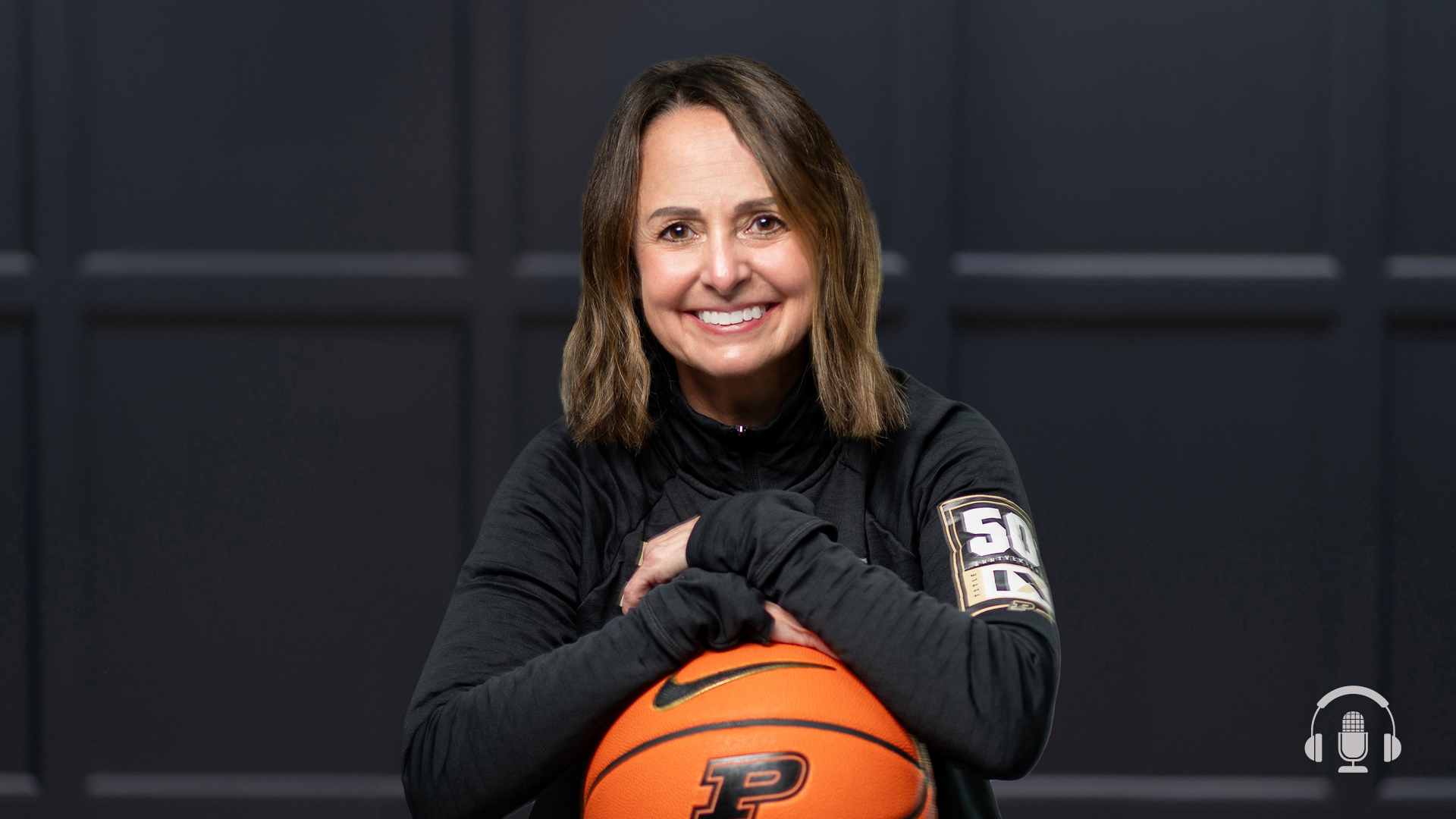Podcast Ep. 125: Purdue Professors Brandon Boor and Nusrat Jung on Their Groundbreaking Indoor Air Quality Research in First-of-Its-Kind Tiny House Lab
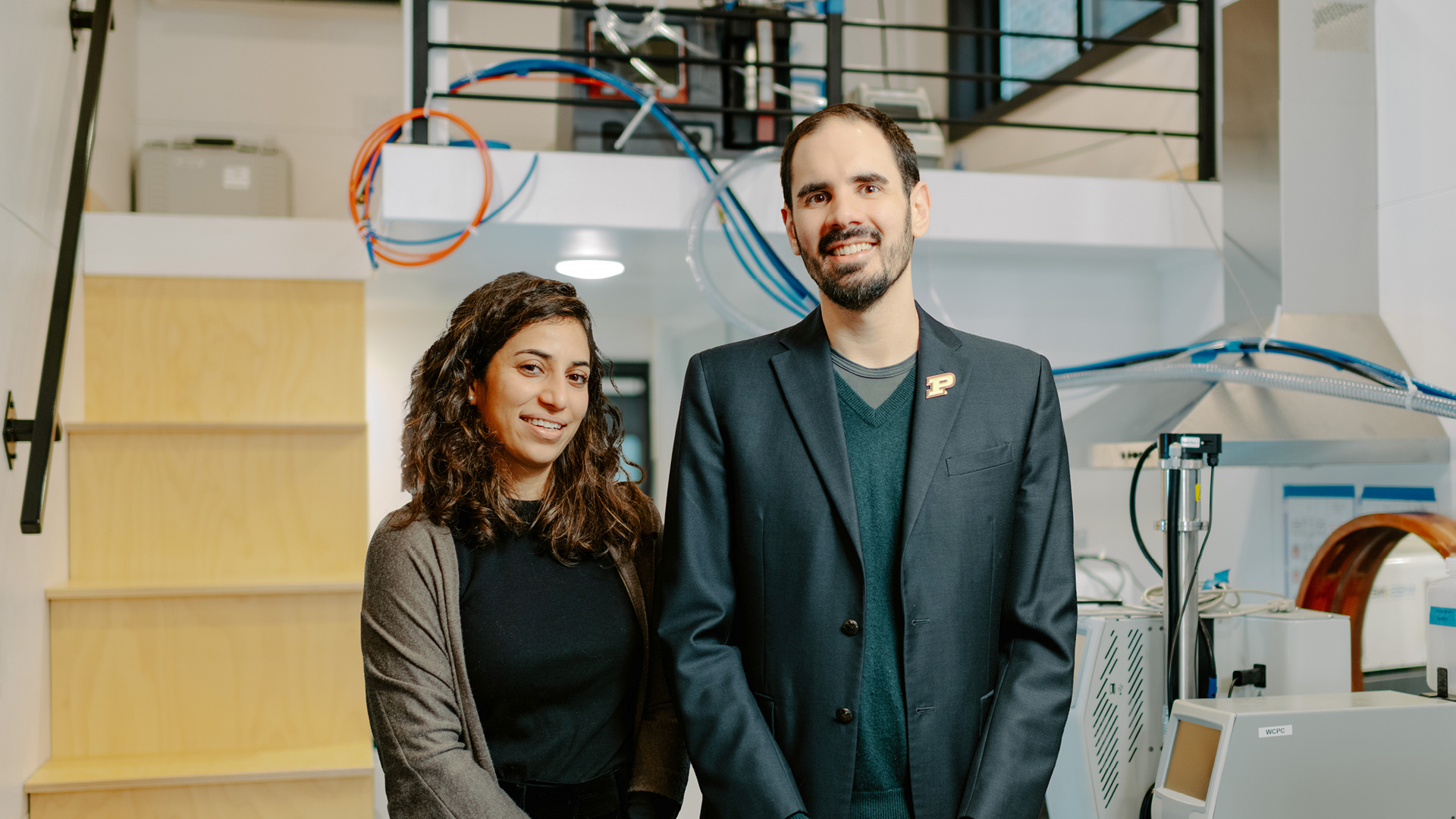
In this episode of “This Is Purdue,” we’re talking to Brandon Boor, the Dr. Margery E. Hoffman Associate Professor in Civil Engineering, and Nusrat Jung, assistant professor of civil engineering.
What’s in the air we breathe indoors? That’s what Brandon and Nusrat are researching in our buildings — at home, school, work and beyond. These two are partners in work and in life, and their cutting-edge research and collaboration with faculty, students and industry partners have led to major scientific discoveries.
In this episode of “This Is Purdue” you will:
- Hear more about Brandon and Nusrat’s journey from Finland to Purdue’s Lyles School of Civil and Construction Engineering and the early experiences that shaped their passion for research
- Understand why indoor air quality research is vital to improving human well-being and how our buildings play a critical role
- Learn about the first-of-its-kind zero-Energy Design Guidance for Engineers (zEDGE) tiny house lab, where they’re utilizing advanced sensor technology to connect their critical air quality research to the real world
- Receive practical advice on how you can improve air quality inside your home or office
- Discover how they’re equipping undergraduate and graduate students with a hands-on education to help them excel at Purdue and beyond
Don’t miss this episode with these Boilermakers who are leading groundbreaking and life-changing research efforts right here at Purdue.
- Learn more about Brandon Boor
- Learn more about Nusrat Jung
- Learn more about the Lyles School of Civil and Construction Engineering
- Learn more about the zEDGE tiny house
- Learn more about Brandon and Nusrat’s latest research on indoor air quality
Read their full research in the links below:
Flame-Free Candles are Not Pollution-Free: Scented Wax Melts as a Significant Source of Atmospheric Nanoparticles
Environmental Science & Technology Letters
DOI: 10.1021/acs.estlett.4c00986
Rapid Nucleation and Growth of Indoor Atmospheric Nanocluster Aerosol during the Use of Scented Volatile Chemical Products in Residential Buildings
ACS ES&T Air
DOI: 10.1021/acsestair.4c00118
Modern buildings act as a dynamic source and sink for urban air pollutants
Cell Reports Sustainability
DOI: 10.1016/j.crsus.2024.100103
Dynamics of nanocluster aerosol in the indoor atmosphere during gas cooking
PNAS Nexus
DOI: 10.1093/pnasnexus/pgae044
Real-Time Evaluation of Terpene Emissions and Exposures during the Use of Scented Wax Products in Residential Buildings with PTR-TOF-MS
Building and Environment
DOI: 10.1016/j.buildenv.2024.111314
Siloxane Emissions and Exposures during the Use of Hair Care Products in Buildings
Environmental Science & Technology
Podcast Transcript
Kate Young:
Hi, I’m Kate Young and you are listening to This is Purdue, the official podcast for Purdue University. As a Purdue alum and Indiana native, I know firsthand about the family of students and professors who are in it together, persistently pursuing and relentlessly rethinking, who are the next game changers, difference makers, ceiling breakers, innovators, who are these boilermakers? Join me as we feature students, faculty, and alumni, taking small steps toward their giant leaps, and inspiring others to do the same.
Brandon Boor:
Our work recently in the past few years has been really focused on understanding the factors that affect the competition of indoor air. Now, what is in the air that we’re breathing, whether we’re sitting in our home, working in our office, or if you have a student that’s out in the classroom at school.
Nusrat Jung:
Air is very fascinating because it is something that you don’t see. So having really, really cool instruments in our lab, allowing us to see what we cannot see.
Kate Young:
In this episode of This is Purdue, we are talking to Brandon Boor and Nusrat Jung and diving into the groundbreaking indoor air quality research they’re conducting right here at Purdue University. Brandon is Purdue’s Dr. Margery E. Hoffman Associate Professor in Civil Engineering, and Nusrat is an assistant professor in Purdue’s Lyles School of Civil and Construction Engineering. Together, Brandon and Nusrat are working to advance healthier, more energy efficient living through collaborative innovation, and this research is happening inside a first of its kind Tiny House lab on Purdue’s campus. In this episode, you’ll learn more about their recent research discoveries like how hair products and wax melts can impact indoor air quality. They’ll also share ways you can improve indoor air quality in your own home. Oh, and by the way, have I mentioned yet that these two are not only a research pair but also a real life pair? Let’s dig in. Here’s my conversation with Brandon and Nusrat.
Thank you both for joining us on the official University podcast, This is Purdue. We’re so excited to talk to you. You’re both civil engineering researchers and professors, and you all have been working on some truly incredible stuff. So we’re excited to dive into this groundbreaking work that you’re doing at Purdue that’s really making a global impact. So, let’s kick things off. We want to get to know you two a little bit better. You are not only partners in research, but you’re partners in life. You’re married. So, we want to know how did you meet and how long have you been married for?
Brandon Boor:
Thank you, Kate. So we’ve been married for 10 years and we first met in Finland in 2011. Nusrat was a research scientist at the VTT Technical Research Centre of Finland, which is a big research center in the country. She was working on buildings research and then I joined VTT as a visiting PhD student. I had a grant from the National Science Foundation called The Nordic Research Opportunity. So I was there for a few months, we met. Working in the same group, the first week that I was there and the rest is history. So, we really enjoyed our time and didn’t want together living up in the far north where it’s quite cold and quite dark, but they have excellent research, excellent education, and I think it really prepared us for our faculty careers here at Purdue.
Kate Young:
That’s incredible. So who else is part of your family, any pets?
Nusrat Jung:
Yes, we have three wonderful cats. Two of them came with us from Finland, and one of the cat adopted us here in West Lafayette. So we are family of five. We were very happy when we moved to Purdue because there is an excellent veterinary school and we were quite worried about the care that involves during the whole lifespan of a pet. So we have been really happy that there are right places and very, very good doctors that are available for anything that they need. So, it’s been a really nice setup.
Kate Young:
I mean, these are international cats. These are special cats.
Brandon Boor:
Yeah.
Nusrat Jung:
Yes, they actually have Finnish passports. It’s really funny story. So they had to travel, the vet issued Finnish passports and the passports have information about the vaccination that they carry and that they are healthy. And it was really funny because I was asking about the Finnish language exam that they skipped.
Kate Young:
That is so fun. Wow. Okay, so I can tell that you’re both very passionate about the work that you do. When did you both realize that science was your passion, and do you remember any moment or experience maybe growing up that you were like, “I really want to be a researcher and make these really cool discoveries?”
Nusrat Jung:
Yes, I remember I was always a very curious child. I was getting into things I wanted to know about things, and I remember in high school we won the first award for science competition. We came up with a chimney that is of a power plant and we wanted to reduce the pollution somehow and come up with a control mechanism that will basically remove the pollution before it is exhausted. I think I have been thinking in terms of emissions and the care for the environment and people’s wellbeing for a long time. So, I’ve always been a person who is needs an active research question in mind or something to look for, something to find, something related to science. And I think the sense of discovery, the excitement that comes with it.
Brandon Boor:
For me, it was also in high school. I grew up in Maryland and we had a Technology Magnet Program at my high school that was really instrumental in introducing me to engineering and science at a young age. I had a chance to participate in rocketry and robotics competitions. I worked at the Johns Hopkins Applied Physics Lab as a high school student. So I think that really drove me towards engineering, really enjoyed tinkering with things, working with my hands, the design aspect of engineering, working as part of a team. And then as a college student, I had the opportunity to do a co-op at the National Institute of Standards and Technology, which is in Gaithersburg, Maryland. They had an indoor air quality research group that I worked with for about eight months, and that introduced me to scientific research, working in the laboratory, working with advanced analytical instrumentation, working with scientists, and I think that really drove me towards pursuing a PhD, pursuing a research career.
I learned that I could do experiments in the lab, make new discoveries, get all this interesting data, and try to make sense of it. There was an endedness to it that maybe is not so traditional and the conventional engineering path. So I think the research path allowed me to pursue my curiosities, do things for the first time in the lab. And make these discoveries that I found to be very interesting, and also impactful because I think indoor air quality is a field that does impact our everyday lives.
Kate Young:
You talked about you were in Finland and now you’re in West Lafayette. That must’ve been a big change. Tell us a little bit about your paths to Purdue.
Brandon Boor:
So I applied to Purdue for a faculty position about a decade ago, and I was fortunate to receive an interview here. There is an open position in architectural engineering. So Purdue University, it’s one that few programs in the United States that has a very strong architectural engineering program within their civil engineering program. And architectural engineering is what Nusrat and I, do. Research-wise, teaching-wise, it’s really to study of buildings, indoor environments, and of course that encompasses indoor air quality.
So I was fortunate to receive an offer and joined Purdue in 2015 as an assistant professor. I’ve been very fortunate to be here because we have such a strong focus on buildings research, research on the indoor environment. And large scale research infrastructure, experimental facilities that really have allowed me to pursue all my interest research-wise. And I think that in terms of the United States and what we have in architectural engineering, Purdue definitely has one of the best programs. We have facilities unlike any other universities, and this has really enabled us to make discoveries that you cannot make anywhere else. So I’ve been very happy to be here for 10 years almost this August, and to work with all the amazing students, undergraduate, graduate students and faculty that we had here at Purdue.
Nusrat Jung:
For me, it was that Brandon moved away from Finland, of course, and [inaudible 00:08:44] I was a PhD student at that time. And for me, it was just so incredibly exciting to see the things you can do when you become a professor. So actually, you have the ability to take something as an independent person, a thought that occurred, and then you can create and build upon it. You can actually write a proposal and then send it out somewhere for evaluation that it’ll get funded.
Of course, there’s a whole sequence of things that you need to do, but at the same time you can really bring your ideas to life and that was very exciting of a thought. So once I was on the verge of completing my PhD in 2018, I actually never saw it as an end of something. I saw it as a new beginning, path to independent research career. So for me, it was incredibly exciting that you can actually do that. The only university I could think of was Purdue because Brandon was here and I wanted to have my dreams come true as well. And it was very exciting to just simply come here and then be a professor. I was teaching a class up to three months of graduating, exciting a new generation of engineers, starting to create new infrastructure. I mean, it has just been such an exciting time seeing all these years.
Kate Young:
When did you first start collaborating on your research together here at Purdue, and what has that experience been like? I’m sure there might be pros and cons with that as well.
Nusrat Jung:
We have actually enjoyed working together quite a lot. So, our first opportunity came during COVID-19, so everything of course was shut down. We had very nice home offices as well, both of us enjoyed working. During this time, there was this opportunity called as Protect Purdue Faculty Innovation Grant, and we had this idea because every time you would go out to groceries or to get something, you would smell all of these disinfectants in the air. And we started to talk about it and convert it into a short proposal that we put in for evaluation in this program, and we were so happy that it was accepted. And that was the first time that we collaborated and we were quite nice to find out that we work very well together. So it’s been really fun to actually have somebody, because naturally of course when you do research, you work in a team. So it is incredibly exciting when you have the whole team invested in the idea. When you make a discovery, it’s even a bigger celebration. So we have now had the opportunity to take our celebrations home as well. So, it’s been quite nice.
Brandon Boor:
It’s been good because we brought different experiences and expertise together, and we did a PhD separately on different research topics and they were both connected to buildings. We were able to leverage the different experiences that we have had throughout our academic and our research careers. And I think that has really helped us in looking at buildings through a unique lens and looking at indoor air pollution issues within buildings. So, I think that’s been very helpful for us to approach a research problem from different perspectives. I think another aspect has been that a lot of the work that we have been doing has been in the form of this large scale measurement campaigns. And this is common in air quality research, whether that’s outdoors or indoors, or basically you bring together many faculty and graduate students to do a very intensive set of experiments at one particular location.
And we have been able to do that here at Purdue, the two of us working together with other faculty collaborators where these measurements are very intense. So we have many instruments up and running that are very complicated, that are measuring all aspects of air quality, all the different pollutants that are in the air, and then all the different factors that are really affecting the composition of air. And then we work with faculty that have different areas of expertise related to atmospheric chemistry, environmental chemistry and so forth, along with industry collaborators.
So these very intensive measurement campaigns that we’ve been able to do at Purdue, have really allowed us to make new discoveries because we’re measuring so many different things that we’re able to pick up on things that maybe other research groups would miss. So I think this has worked very well, but it takes a lot of work, a lot of coordination, and a lot of project management to oversee such a large research team. And to make sure that all these instruments are working together in unison because a lot of our work is looking at real-time dynamics of air pollutants.
So everything has to be synced down to the second so we can make sense of the data that we’re generating, and we generate tons of data in our measurement campaign. So, I think working in this format has been very productive for the two of us along of our collaborators. And producing new research insights related to the factors that affect air quality in your home or your office or in the school.
Nusrat Jung:
And especially beneficial for our graduate students. So our graduate students have rights, they can come to us very easily and say, “Hey, Dr. Jung, this instrument I’m really interested in using in Dr. Boris lab. Is that okay?” And I’m like, “Okay, let’s go talk to him.” So it’s an easier conversation. Students have really enjoyed having the open opportunity to collaborate between our labs and so on. And of course, we have many independent projects as well that go on. We are also interested in our independent thoughts and ideas that we pursue them. We also work with many other faculty colleagues. I mean, it’s a mix of everything. It has been quite nice.
Brandon Boor:
I should add that we have worked with IU Indiana University. They have, of course, been our rivals on the basketball court, but we’ve worked with them on many different research papers related to indoor atmospheric chemistry, which has been certainly a positive aspect of a research here at Purdue.
Kate Young:
And speaking of Purdue basketball, you can check out some additional bonus content and hear what Brandon and Nusrat enjoy doing together in our Boilermaker community on our podcast YouTube page, youtube.com/@thisispurdue. Now, for the past few years, Brandon and Nusrat have been focused on indoor air quality, and studying airborne particle emissions. And how architectural designs and energy-efficient building innovations can impact air quality. So, what’s been this pair’s biggest takeaways from this research so far?
Brandon Boor:
Work recently in the past few years has been really focused on understanding the factors that affect the composition of indoor air. What is in the air that we’re breathing, whether we’re sitting in our home, working in our office, or if you have a student that’s out in the classroom at school. What are the factors that are affecting the air pollution that we’re exposed to? And we try to approach this from different angles. We want to understand how the building affects air quality. Buildings have a big impact on the air that we breathe, whether that’s protecting us from outdoor air pollution, for example, wildfire smoke. We’re contributing to the transmission of respiratory viruses like SARS-CoV-2. But we try to look at it through the perspective of buildings they’re designed and their operation because there’s a lot of opportunity there to make buildings that promote their health and well-being.
So whenever we do our measurements, we always try to do it in the context of how is the building affecting the composition of air, affecting sources of air pollution, the removal of air pollutants and so forth. Then we also want to look at occupants. So in any indoor environment, people play a big role in what’s going on, whether that’s energy consumption or air quality. Our very presence is releasing a variety of different gases and aerosols to the air around us.
So we try to look at the role of the occupant, and we have done studies in the Herrick Living Labs looking at this in the zEDGE Tiny House and other facilities where we’re trying to frame the research around people, whether that’s a lot of people present or just one person that’s cooking on a stove top. So we found that occupancy, occupancy patterns, and occupant activities, cooking, cleaning, using personal care products have a big impact on the air that we breathe. So it’s really looking at air quality through the lens of buildings and people, and then trying to frame our results in the context of how can we improve indoor air quality and what are we exposed to? What are we inhaling into our body that may ultimately affect our health?
Nusrat Jung:
I very often when I start my class, I do speak about this number that we spend 90% of the time in buildings. When you say it in a sentence, you actually don’t think very much about it, but when you start to think how we are spending our everyday life, then it makes more sense. So for example, you are waking up in a building when you get ready to go somewhere, you go to another building, then you go to another building. So somehow we are moving through many buildings throughout our day and it is incredibly important to understand the fundamental processes that are occurring in these spaces.
And what may be driving the change in the air that we are breathing, be it outdoors and indoors. So outdoor and indoors are both connected. We have outdoor air that we are going to bring into the… So many ways that the air can come in. Here is very fascinating. I find it to be very fascinating because it is something that you don’t see. So having really, really cool instruments in our lab allowing us to see what we cannot see. So we are able to measure a large particle size distribution in terms of aerosol science, and we are also able to understand the chemistry of the air, so chemical speciation of what is in that. So ultimately, we are trying to understand the constituents of what is in this air and how rapidly it changes because of the activities he conducts in these buildings every day.
Brandon Boor:
I would add that at Purdue University, we’ve been very fortunate to have access to all the most cutting edge air quality instruments. Some of these we own here, they’re in our lab, and some have been on loan to us from our industry partners, but we’ve been really excited to use these really cool sensors, basically. And these are very sophisticated sensing technologies that allow us to measure all sorts of things with excellent resolution. And that has enabled some of the discoveries that we have made. And we’re able to, for example, measure incredibly small airborne particles, nanoparticles that are present in the air when you’re cooking on a gas stove, we’re able to measure all these different chemicals that are in the air second by second. So, I think having access to all this really cutting edge technology at Purdue is really advancing our research. It’s very exciting for us and our students to use this equipment and to bring it all together to tell a story about indoor air quality and what affects it.
Kate Young:
So, how and where exactly are Brandon and Nusrat conducting their research? The Purdue Zero Energy Design Guidance for Engineers or zEDGE lab is a 192 square foot tiny house that has all of the features of a typical home that is equipped with sensors for closely monitoring the impact of everyday activities on a home’s air quality. This lab is so uniquely Purdue, and it’s the only residential lab space for indoor air quality research. Nusrat shares more about the Tiny House lab, plus digs into one of the biggest discoveries from her and her team’s indoor air quality research. How chemicals like siloxanes found in hair care products can linger in the air after its use.
Nusrat, I want to talk to you about the zEDGE Tiny House. you and a group of students designed this back in 2020. Tell us more about this lab. It’s the first of its kind. It’s the only one of its kind. How does it add to Purdue’s status as a global leader in this specific research?
Nusrat Jung:
We are continually working to elevate our status. So we are the gold standard, and I really want to continue to strive to recreate the best. I was very fortunate to have received education in India, in Germany, in Finland, and I have a very enriching experience in all of these countries. So when I moved here to the United States, I really wanted to create something that amalgamates all of my experiences, and that resulted in creation of this perfectly tiny house which is also a super high-tech lab. It is a house because we want to provide our audiences to our students, to our researchers, to our fellow people something to relate to. We live in houses, and it really helps connect with the real world activities. So in this lab, everything is looking as if it is a normal house, but it is outfitted with thousands of different sensors.
We are sensing everything. So this serves for us something called as a completely mixed flow reactor. That means if I were to cause a little bit of pollution in this lab, all of my instruments will light up and collect that data set. And then that data set would allow us to identify, is there an issue with this pollutant? Is there something that we need to be worried about? So this very unique lab has been the source of so many discoveries that have come out from our research lab. One of the major discoveries that we reported last year had to do with chemical products that we are applying in our hair. You mentioned, hairspray, right before you got ready today, I am not so happy to share that perhaps it’s something to avoid. So we found that normal hair care products that you find in grocery shops, any shop that you would go to, it’s actually I have to say quite amazing the number of products there are.
So if you go to any store, you would see the aisles are filled with them, and we rarely are looking into the composition of the product, right? Because of course we all want to look good, we want to get ready in the morning and improve how we look because that’s how we function as a society. But at the same time, we don’t wish to be exposed to harmful chemicals. So we found that while we are conducting our everyday care routines, we might be exposing ourselves to very high levels of a compound called saloxane. And this compound is bioaccumulated, it is toxic, and it is really not something you should be exposing yourself to. And if you were to be someone who is using a treated appliance in tandem with application of the product, that further exacerbates the volatility of the product. So, this activity is quite unique because you do it every day, but you don’t realize that you’re breathing right here, right?
So this is our nose and our mouth and this is the delivery of air into our lungs. So, why did we want to deliver the air into advance? We really want to avoid the chemical delivery into our body, to our system. So my general advice about air quality or indoor air or how to avoid this is really being aware of what you are purchase. Always remember, it is a chemical mixture and this mixture as much as it may make you look better or look certain way, it might also be doing other things. So it’s a good idea to always read the products that are behind, and somehow gain an understanding that perhaps reducing our exposure is our number one option. So reduce the number of these products that we bring into our home and possibly avoid things that are scented.
So it’s nice to use fragrances every now and then, but a continuous exposure during several times a day of something that is chemically charged can possibly not be good for us. I mean, just to think naturally. We all know taking a walk through a forest is a nice thing, but we rarely come across like a whole bed of roses in terms of perfume. I just think about it in terms of my grandfather’s advice, “Everything in moderation,” maybe is the way to go.
Kate Young:
I have a strong feeling that our listeners and viewers at home are thinking, “What can I do? What can I do to help control the air quality in my house? How can I still enjoy scented products?” I just sprayed some hairspray before this interview. I know we talked about perfume. Is there anything that we all can do to help improve our air quality at home, in our workplace, et cetera?
Brandon Boor:
So three strategies to improve indoor air quality in your home or an office, the first is better ventilation. This is something that came to light with the COVID-19 pandemic that buildings are just not ventilated sufficiently. So ventilation is a great way to bring in outdoor air to dilute all the contaminants that we’re generating indoors. These can be pollutants that are produced during cooking, [inaudible 00:25:56] activities, but also the human body. So, we’re releasing viruses into air, bacteria, carbon dioxide, and these pollutants can build up over time if buildings are not sufficiently ventilated. So ventilation is a great strategy, but we need to sometimes make renovations to buildings to ventilate them better, install new HVAC equipment. But this is something that can be a very effective mitigation strategy. The second would be filtration. And this can be done within the HVAC system. So the furnace that may be down in your basement or up in the attic, filters can remove contaminants very efficiently.
We can create do-it-yourself air purifiers that we can place in your bedroom. We can put it into a classroom and those can scrub out pollutants quite efficiently. So filtration is a great strategy to us from all the stuff that we’re generating indoors like viruses and bacteria, but also pollutants that may be coming from the outdoors. So wildfire smoke for example, if you’re living out in California and your home is exposed to wildfire smoke, how could you protect yourself, or you can use better filtration. And these filters can remove the particulate matter from the air. The last is to look at the different sources of air pollution around us. So when we go to the grocery store to buy different products that we bring into our home, we should be thinking about the different types of chemicals that may be present in those products. Some of those are listed on the label, some may be not listed.
We have to be mindful that our buildings are chemical reactors and we bring in a lot of household products, a lot of personal care products, cleaning products that do contain chemicals of concern. I think this is something where if you just don’t use those products, you could reduce your exposure, but some things are hard to get away from. And some of these sources are connected to the building itself from the different furnishings and building materials that we use. So we have to be thinking about long-term, how can we create products that do not have hazardous chemicals in them? And to raise awareness about the chemical loadings of our home of the indoor environment. Things like forever chemicals like PFAS are quite ubiquitous, and they’re found in many different things. So we have to be thinking about how can we remove these pollutants from the indoor environment, whether it’s better ventilation, better filtration or source control, just not bringing this stuff into our home. These are all effective strategies.
Nusrat Jung:
We talked about filtration. That’s great. We want to filter, we use filter media. In buildings, we can improve that. I think the bigger issue is going to be in cities because in cities you are really close to each other’s exhaust vent. So, exhausting everything out of a building may remove it from your immediate breathing zone, but it does not remove it from the atmosphere.
So we have to understand that buildings are pumping out chemicals and aerosol pollutants into the air that then become part of the whole atmosphere. So, it is a shared volume of air that we have access to, and what can we do to better it? We can really start with looking into these pumping of chemicals. We need to think about how do we filter the air that we are sending out in the world as well. So, we do have solutions and ideas in mind. We do have new discoveries that will come out that will be reported. But it is important to think of systems as a whole, buildings as a whole, the whole world as a whole, how everything is interconnected. So interconnectedness of all of these systems do, they are very important.
Kate Young:
So haircare products impacting indoor air quality was one major discovery found from the research being done in the Tiny House lab. But these two researchers are working on another major finding, which involves a popular cozy ritual. In their paper titled Flame-Free Candles are Not Pollution-Free, which was recently accepted by Environmental Science & Technology Letters. Brandon and Nusrat found that scented wax melts actually pollute indoor air as much as normal candles do. The pair explains more.
Nusrat Jung:
If you go to any grocery store, but notice that you have candles on one side which has combustion elements. So you have to light it up. And then you have something called as wax melt, which is something that you put in a wax warmer so you don’t have that lighting part of it. So basically we wanted to study, “Hey, what is the real difference in it?” Because they are being sold these days as pollution-free possibility to create scented atmosphere homes. Our major discovery here really led us to understand what is happening in terms of the chemical pollution they are generating at the house. We also notice the really high amount of fragrance that it is injecting beyond a candle that we would purchase normally.
Brandon Boor:
We found that even though the wax warmer, the wax melt has no combustion involved, we’re actually generating similar amounts of airborne nanoparticles as you would have with a candle. So this is a non-intuitive finding. We buy these products, you’re not burning anything. You think that you should not be generating any smoke or particulate matter, but in reality you are. So this is something that we have reported on in a number of papers recently, and that these fragrances that Nusrat is describing are highly reactive, that highly reactive with things like ozone. Ozone comes from the outdoors via ventilation and it can initiate very complex chemical reactions that can form very high concentrations of very small nanoparticles that can get deep into our respiratory system. So what we found is that using these fragrance wax melts can actually produce a lot of nanoparticles. You don’t see them, we don’t see visible smoke, but these particles can impact our health.
We think they can cause issues with our respiratory system, and we need to be aware that these particles are being formed within the indoor atmosphere. These are processes that are not so simple to understand, but they are occurring in the air around us throughout the day. And they can just be initiated with this burst of fragrance that we release, these very reactive molecules. So, hopefully people could understand that these fragrance products when they smell like lime or lemon or orange or pine, can initiate the formation of very small particles, which can get deep into our respiratory system. And again, this is not something that you would be aware if you’re just looking at the product because you cannot see the smoke particles.
Kate Young:
We’ll link their paper in our podcast show notes for you if you want to dig into more detail on this research. Both of you have talked about the industry partners with Purdue and the benefit that we have to work with these types of partners, and I know they’ve benefited from the Tiny House lab as well. So why is that an exciting opportunity for Purdue to work with these industry partners?
Nusrat Jung:
We really are very excited to have this opportunity to work with all the industry partners. I’d like to highlight that the equipment we have on the Tiny House, for example, all the appliances and other equipment, they have been donated by two of the largest HVAC companies. We also have industry partners who have contacted us to actually test their instrumentation. So when they see that such creative, exciting discoveries are coming out of this research lab, they really want us to find out the capability of their instruments.
So we are able to really test the lower threshold and the higher threshold of whatever product that they are producing because we are able to measure so much in our lab. So it has been very exciting to form new industry collaboration. It has happened on several occasions that we have received the instrument to test in our lab before it has been released to the public to purchase. So we are really fortunate because we are always excited with the ability to measure air. If we can do that and help advance industry as well in that direction, we are very happy to take that as I mentioned.
Brandon Boor:
I think that Nusrat highlighted the benefit of working with industry partners, especially related to measurement technologies for air pollution. This has been something that has really helped our research to move it forward. Going back now almost half a decade, working with different companies around the United States and beyond, to use the most cutting edge instrumentation to measure different aspects of air quality that very few people in the world can measure. I think this has really been quite fun for us to use these instruments in Nusrat’s Tiny House, which is such a controlled atmospheric environment. So we can run these very controlled experiments, which enables us to make deep fundamental insights. Since we know everything that’s going on inside the Tiny House when we bring in an instrument, we have the ability to really characterize air pollution dynamics very carefully with a level of precision that you could not do perhaps in other environments. So I think working with companies, working with their cutting edge instrumentation inside of Nusrat’s Tiny House has really been a great experience for the two of us.
Kate Young:
I know our This is Purdue team had the pleasure of meeting some of your students. It’s so unique for the to be working in this one of a kind lab as well. What are you hoping that they take away from it?
Nusrat Jung:
Okay. First I have to acknowledge that at Purdue University we do a very good job in providing opportunities of research to our undergraduate [inaudible 00:35:54]. That is so important because it’s not just about going through a curriculum for an undergraduate students, it is also about being part of our discoveries. This is really unique that they have an opportunity here at Purdue to participate in our discoveries. We have programs such as OUR, Office of Undergraduate Research. We have also had students from SERF, which is Summer Undergraduate Research Fellowship. We have also had many students that have come from international programs. We have had students from, I think Contest Program from Brazil. We have also had the students from recently all across the world and United States. The students who go here to Purdue have been part of our lab. We also have an [inaudible 00:36:40] which is project management team and where the students really work together in groups to create new engineering solutions.
All of these students have had access to the tiny house to conduct research with our research groups. So overall, I think over hundreds of students have gone through the lab in terms of taking away new knowledge. I think the number one thing I would like students to take away from this lab instead, buildings are very complex engineering systems, and each building presents a new challenge because it functions differently. For example, a hospital would function very differently than a residential house.
So what are these parameters that make them different? What are these parameters that make them unique, and what are the things we have to be consistently careful about as engineers to improve our build environment? So I think this lab has allowed the students to have an understanding of these individual parameters that they need to care for to actually create an exceptional built environment. As civil engineers, we really play a very [inaudible 00:37:56] society, we are the foundation of society. Everything we do is behind the scenes, but all of the infrastructure that exists, really civil engineer has a huge role to play with that. So we want to basically enhance their learning in our lives, and hopefully provide them with skill set where they can make better decisions when they go join us [inaudible 00:38:19].
Kate Young:
It sounds like you’re both really passionate about teaching about your students. How do you think that the things that they’re learning at Purdue through the two of you specifically, how will that lead to them solving these tough challenges as we look into the future?
Brandon Boor:
I think we’re trying to give our students a holistic understanding of buildings, which are a critical part of our built infrastructure in the United States, that we want to create buildings of the future that promote our health, our well-being, our productivity that are energy efficient, that integrate all the latest advanced sensing technologies, control technologies, appliances and materials. So I think within civil engineering, within the architectural engineering program, Nusrat and I, our faculty colleagues are really trying to help students, undergraduate and graduate students view buildings holistically. And really have a strong grounding in the fundamentals, the fundamentals of thermodynamics, heat and mass transport and so forth. So they can go into the workforce and bring with them all this new knowledge so they can design buildings of the future that outperform the buildings that we have now that can address issues like indoor air quality needs, optimized lighting and thermal comfort, keep people in the center.
I think that buildings are designed and created for people. I think that’s something that we try to integrate into our teachings and into our research. We have a lot of opportunity through engineering, through design, to create buildings that optimize our performance, whether that’s in the home or in the office of the classroom. So I think that’s something that we’re trying to focus on for our education program and architectural engineering. And I think we have been successful with that. And I think that we will continue to work on helping our students understanding emerging challenges, societal challenges related to energy, environmental pollution and so forth. So they can really be the leaders. And I think that at Purdue, students get a great education, whether that’s in the fundamentals, but also as Nusrat explained, all this hands-on experience that they can get here through ethics, through research experiences, through co-ops and things like that. They can get a very holistic experience that will prepare them for the workforce or for perhaps a research career if they end up becoming a professor.
Nusrat Jung:
We are always excited to see all of them succeed. The way we approach learning in both research and teaching, it’s really also focused on to not shy away from the complexity of the problem. In fact, be very easy about it, take it easy in terms of how complex it is. So understanding something requires that you become comfortable with it being a very complex challenge to solve. So all the students who have gone through our labs, they are very, very, very much at ease looking at large quantities of data set, looking at huge problem in terms of what they are trying to solve, and then really taking a deep dive into each of the items that may have an impact.
So I think it’s not just about one thing, it is really about the whole picture. The students in our labs have and in our classroom have a very holistic understanding. So, they’re not just book smart. We want them to be actually smart, like really smart. So we try to provide this real environment that we always want to bring them back to reality, that all of these things that they are learning in our classroom have a very real use in the real world, and having mastery of what they are learning here will definitely improve their ability to meet in the future.
Kate Young:
Between facilities like the zEDGE Tiny House lab and the innovative Boilermaker collaboration happening daily, Purdue is a global leader when it comes to environmental health research. Brandon shares more.
Brandon Boor:
I think one aspect to that has been the research infrastructure available to Purdue faculty and students. We have a lot of large-scale infrastructure in place so we can do cutting-edge experimental work. I think that’s one of the reasons I’ve really enjoyed being here. Whether it’s been Nusrat’s Tiny House or other facilities that we have access to, these large labs have really allowed us to do really cool things at a scale that you cannot do at other universities. For example, in air quality research, a lot of people may study processes in small chambers. Here we can do full-scale test houses and offices and HVAC systems. I think that has really allowed us to do work that’s fundamental, but has a strong practical element because it’s done in a real environment.
So I think that’s been very unique. And I think over the past decade and being at Purdue, I think there’s been a growing number of faculty that have working on environmental pollution issues, whether that’s air quality, water quality, and you’re collaborating together. And we have worked with a number of faculty within civil and environmental engineering chemistry tried to study some of these different environmental pollution issues. So I think there’s been a growing focus at Purdue. He’ll look at the environment to try to understand where the pollution is coming from to try to mitigate that pollution, and that really requires expertise from many different areas, engineering, science, health, and so forth.
Kate Young:
Okay, last question today, it’s a big one. You get to see all the amazing work at Purdue, all of the researchers in the different fields, what they’re doing every day. What do you want the world to know and remember about the work that Purdue is doing?
Brandon Boor:
So I think Purdue is a leader in engineering research. Being here, I can see that we’re doing really cutting-edge research. We’re doing research that a lot of universities and the world just cannot do because we have the infrastructure in place to do these full-scale investigations. And that spans all the engineering disciplines, whether it’s aerospace to civil, to mechanical and so forth. I think we are just doing really cool things at Purdue that impact society. I am happy to be a part of this engineering program because we’re really focused on doing high quality research on buildings. And I think this is making a difference and I think it will continue to make a difference. The two of us are looking more at the indoor environment, the indoor air quality part of that, but there’s just so much research at Purdue on buildings and how to make them healthier, more energy efficient, and it’s really cool to be a part of that and to see so many different faculty and students studying our built environments from different perspectives.
And all this high quality research that we produce at Purdue does have an impact. People read it, researchers from around the world read our papers and they learn about the knowledge that we’re generating here in our lab. So we’re sitting in this Tiny House and we can make a discovery and we can publish that. And somebody in Europe, somebody in Asia can read these papers and learn about the new knowledge that we have created. And this can transform the whole research enterprise globally. And I believe that’s what we’re doing at Purdue. We have a lot of very productive faculty that are really generating high quality research that does play a role that can affect policies. It can provide the general public with new insights, and just great to generate this knowledge because it’s something that’s so important. Science is an important part of society, and a lot of this science starts with professors and students and doing really deep work. And I believe that Purdue is a leader in doing this really deep fundamental work that has this practical aspect to it, whether it’s health or technology or so forth.
Nusrat Jung:
I also believe it is also the years of training and the years of experience and expertise that you’ve built over the year, right? So there are several years of work has brought to all of these discoveries that have come out. And it is not just simply about your ability to measure, it is also about your ability to take that data, do a deep dive into it, build the mathematical models that allow you to actually see the discovery, then fine tune this work, then publish the work.
So all of this is really years of hard work that has gone into what has come out of our labs. So, it is the representation of extremely dedicated students that we have very committed professors, exceptional environment in our classrooms of innovation, or excitement about the future. So all of these things when they culminate together, you really do have something brilliant and outstanding. So we are both really excited to be here and to be part of this culture, and also creating our old culture around us. So it’s really just been such a wonderful time and we continue to be excited still every day when we come to the lab, which is quite amazing.
Kate Young:
We got to witness a little bit of your culture with the students and getting to see the Tiny House lab in person and getting a tour of that. So we will link that for our listeners as well, and they can check it out on our YouTube page. And speaking of this one of a kind Tiny House lab, Nusrat shares one last interesting fact about the design of this lab that may surprise you all.
Nusrat Jung:
So this is very funny. Our toilet doesn’t have a door. So it’s funny when everybody comes in here is like, “Professor Jung where is the door?” I don’t want you to use the toilet, which is why there is no door. So of course it is a house where it’s a lab, and we really want to avoid activities such as using the toilet in the [inaudible 00:48:05]. So that is really funny every time that happens, I have to give a little bit of an explanation to everyone about why we don’t have a door, but we have a toilet. It flushes, it works because of course we also want to monitor all the flows in the building, right? We also have a water meter, and at different points, we are also measuring what is flowing in the building and flowing out of the building. So we want to have a system level approach, to a very engineering approach to all the problems that we look into.
We are measuring energy, we are measuring air, we are measuring all of the water that flows through the building. We are measuring how these different appliances are operating, what effect they have on the air inside. So we really believe in measuring things because when we measure, we can identify. And the quality of the equipment that you measure with is also very important because you might be looking for something that the instrument cannot detect, so you will never find it out. So it is important to really have a holistic engineering, very scientific approach to looking into each and every query that we conduct in our research labs.
Kate Young:
Now, that’s an interesting behind the scenes tidbit right there. Remember, if you want to see this incredible Tiny House lab firsthand, you can watch a special tour with Nusrat on our podcast YouTube page, youtube.com/@thisispurdue. Well, again, thank you so much. I know our listeners and viewers are going to certainly learn a thing or two from this episode, and it was a pleasure talking to you both.
Nusrat Jung:
Thank you, Kate, so much. We really enjoyed speaking with you. We wish you a very nice happy New Year.
Brandon Boor:
Thank you, Kate. This was a fun experience for us.
Kate Young:
It was a pleasure getting to know these Boilermakers civil engineering professors and researchers, their passion for their research, their students, and the Purdue community really shines. Remember, there’s additional bonus video content from both Brandon and Nusrat on our YouTube page. They walk through more details and suggest useful tools you can use to improve your air quality at home. Trust me, you don’t want to miss it. And of course, be sure to follow, This is Purdue on Apple Podcasts, Spotify, iHeartRadio, or wherever you get your podcasts as we continue rolling out new episodes this season. This is Purdue is hosted and written by me, Kate Young. Our podcast videography for this episode was led by Ted Schellenberger. Our social media marketing is led by Maria Welch. Our podcast distribution strategy is led by Carly Eastman. Our podcast design is led by Caitlin Freeville. Our podcast photography is led by John Underwood.
Our podcast team project manager is Raine Gu. Our podcast, YouTube Promotions is managed by Kristen Bowman. Additional writing and research assistance is led by Sophie Ritz and Ashwini Malshi. Our video production assistant is Delaney Young. Our This is Purdue intern is Caroline Keim. And Kayla Elbert is the author of several Purdue news articles featuring Brandon and Nusrat’s Research, which you can check out in our show notes. Thanks for listening to This is Purdue. For more information on this episode, visit our website at purdue.edu/podcast. There you can head over to your favorite podcast app to subscribe and leave us a review. And as always, boiler up.
